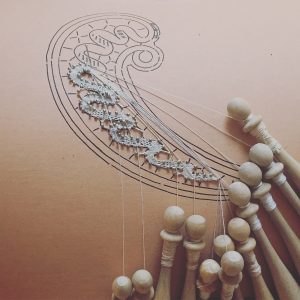
Many people that are passionate about crafts and handmade art, may have stumbled upon videos that show talented artisans making handmade bobbin lace.
This craft is very ancient, bobbins made in bone have been found in Etruscan tombs, in excavation sites in Greece and in many other archeological sites in Europe. It is hard to put a date on this skill, but the modern bobbin lace art can be roughly dated to the XVth century. Some historians think it started in the Flanders area, others according to a report on a sale of “12 bobbins” in 1493 Milan, give the modern bobbin lace Italian origins, it is uncertain and lacemakers get even upset about it 😀 !
Lace was highly sought during and after the renaissance period, both women and men used it to embellish their clothes and home wear, the Flanders area was the first to monetise this art in a advantageous way with lacemakers having contracts to export their works all over Europe. They where then followed in this by Italy and later France, England and Spain.
Bobbin Lace became a status symbol of the wealthy and so remained for many centuries, women and families would save money so to have items embellished by it or entirely made by it in their dowry, home and clothes. A lacemaker once could make a good living for herself and her family, it was an art performed entirely by women. With the industrial revolution and the mechanisation of lace making, this art sadly started to be lost and slipped away. In Italy few locations retain the art and are famous for how it is practiced, the areas of Venice, Como, Cantù, Offida, Scanno, Pescocostanzo. In the U.K. there is a “Lace Guild” to my understanding that keeps the art alive. According to the country the lace techniques, threads and methods vary.
And alas lets come to me. I have spent much of my childhood in the Como area, and have early memories of elderly ladies making lace on the typical “Tombolo”, a kind of cylindrical pillow that they use to set the work upon. I was fascinated by the agility of the women’s hands with the “fuselli” (bobbins). Life went on and I enjoyed other crafts, including tatted lace, but forgot the bobbin lace as all the ladies in the village I spent my summers in had died. Six years ago while walking in the mountains over Menaggio on Lake Como, I ended up eating in a lovely home managed restaurant, in a corner of the room was the “Tombolo”, I fell in love.
By then I was not living in Italy anymore as I had moved to the U.K. with my husband, so going to the school in Cantù was not a possibility. I had to find a teacher. And as many of the last lacemakers are very jealous of their skills, and many more are not alive anymore, it took me 4 years to find a teacher. Meeting lovely Gigliola two years ago, that was willing and still is, to teach me, was a real blessing. This summer I will attend my last lessons with her and then I will be capable of moving to more intricate projects and in many years call myself too, a lacemaker.
It is a satisfying art, not only you create things of intricate beauty that are unique (as every lacemaker has her own style and often her own patterns), but if you thought that knitting is a great form of meditation or mindfulness you will be blown away by bobbin lace. It is an art that has been recently recognised Human Heritage by UNESCO and it is a thread connecting me to all the women before me that practised the same art and kept it alive in history.
If you would like to learn more about Bobbin Lace, here are some sources I can recommend:
MANI DI FATA WEBSITE : It is one of Italy’s best haberdasheries, they send items in all of Europe and have started to give Bobbin Lace lessons again in the last years, thanks to the amazing work of the young gentleman that runs THE LACEMAKER DIARY
There are some nice books you can order at your local library or online on amazon and those are:
